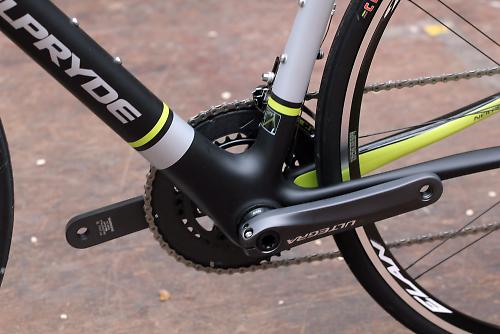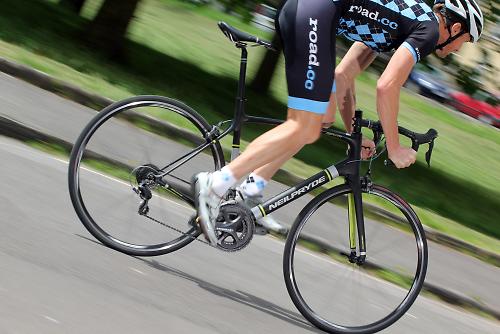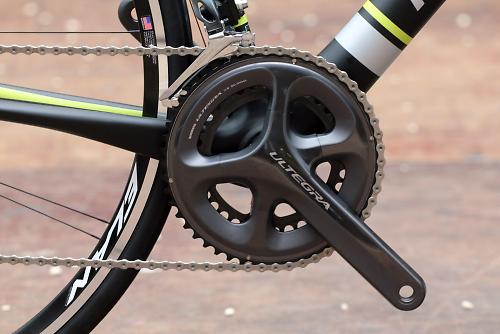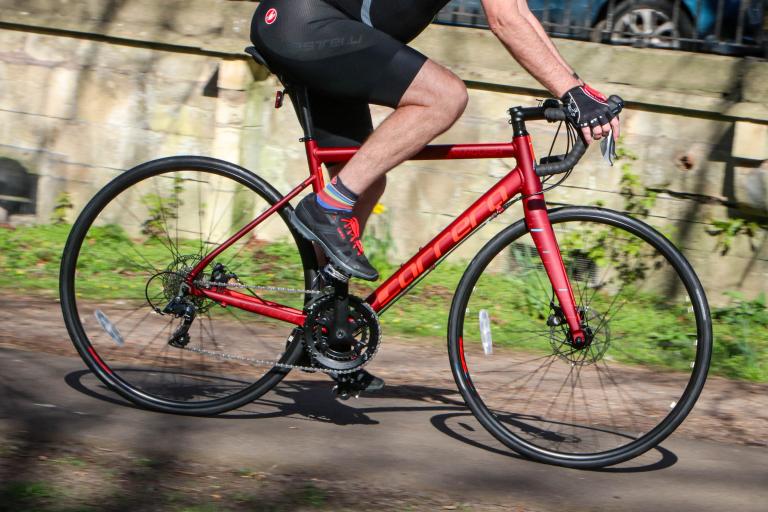- News
- Reviews
- Bikes
- Components
- Bar tape & grips
- Bottom brackets
- Brake & gear cables
- Brake & STI levers
- Brake pads & spares
- Brakes
- Cassettes & freewheels
- Chains
- Chainsets & chainrings
- Derailleurs - front
- Derailleurs - rear
- Forks
- Gear levers & shifters
- Groupsets
- Handlebars & extensions
- Headsets
- Hubs
- Inner tubes
- Pedals
- Quick releases & skewers
- Saddles
- Seatposts
- Stems
- Wheels
- Tyres
- Tubeless valves
- Accessories
- Accessories - misc
- Computer mounts
- Bags
- Bar ends
- Bike bags & cases
- Bottle cages
- Bottles
- Cameras
- Car racks
- Child seats
- Computers
- Glasses
- GPS units
- Helmets
- Lights - front
- Lights - rear
- Lights - sets
- Locks
- Mirrors
- Mudguards
- Racks
- Pumps & CO2 inflators
- Puncture kits
- Reflectives
- Smart watches
- Stands and racks
- Trailers
- Clothing
- Health, fitness and nutrition
- Tools and workshop
- Miscellaneous
- Buyers Guides
- Features
- Forum
- Recommends
- Podcast
review
£2,899.00
VERDICT:
Responsive performance/race bike with added comfort
Weight:
7,500g
Contact:
At road.cc every product is thoroughly tested for as long as it takes to get a proper insight into how well it works. Our reviewers are experienced cyclists that we trust to be objective. While we strive to ensure that opinions expressed are backed up by facts, reviews are by their nature an informed opinion, not a definitive verdict. We don't intentionally try to break anything (except locks) but we do try to look for weak points in any design. The overall score is not just an average of the other scores: it reflects both a product's function and value – with value determined by how a product compares with items of similar spec, quality, and price.
What the road.cc scores meanGood scores are more common than bad, because fortunately good products are more common than bad.
- Exceptional
- Excellent
- Very Good
- Good
- Quite good
- Average
- Not so good
- Poor
- Bad
- Appalling
The NeilPryde Zephyr is a comfortable performance bike that's a blast to ride. Here are four key things that you need to know about it.

1. Relaxed geometry
Okay, let's say right away that there's 'relaxed geometry' and there's 'relaxed geometry'. Really, the Zephyr comes in a 'more relaxed than other bikes in the range geometry'. In the overall scheme of things, it's not all that relaxed.
As clear as mud? Okay, so the Zephyr's front end is just a little higher and a little closer to you than the front end of NeilPryde's Bura sl race bike, for example, but the difference isn't massive.

We have the large sized Zephyr in for test. It has a reach (the horizontal distance between the centre of the bottom bracket and the top of the top tube) of 378mm whereas the Bura sl's is 385mm. The stack height (the vertical distance between those two points) is 578mm compared to 574mm on the Bura sl, so we're talking about fairly small differences here. The difference in geometry between Specialized's Tarmac road bike and their Roubaix endurance bike is far greater, for example, and the Zephyr's 17.5cm head tube is hardly lofty on a bike of this size.
NeilPryde say that the geometry is 'suitable for the longest of races', and that gives you an idea of where they're coming from; it's tall but still racy.

Your ride position isn't so extreme that you're going to struggle to maintain it over the course of a long ride (probably; we're all different, of course), but it's not so upright that you have to bin off the idea of aero efficiency. It sits somewhere in the middle of those two extremes.
Plus, if you are going to have your handlebars at about this height, you're far better off having a slightly longer head tube like this one than having a shorter head tube and a stack of spacers underneath the stem. That latter route is going to compromise front-end stiffness which you'll notice especially when you're riding out of the saddle or cornering hard.

I was riding the Zephyr over the course of a month and it worked fine for me, even for century rides and beyond. When a bike has a very high front end I struggle to get into a position I'm happy with when riding in the saddle, and it's a nightmare when I want to ride uphill out of the saddle or sprint. I just can't get over the front end enough to chuck the bike around.
That's not the case with the Zephyr. You can still get aggressive here, both in terms of your ride position and your behaviour. It still feels like a race bike, it's just that the geometry isn't quite as extreme as you'll find on a lot of other race bikes.

Check out the geometry tables on the NeilPryde website to see if it's right for you.
2. The compliance
The Zephyr is made using C6.7 carbon, a blend of Toray T700and 46T, and NeilPryde talk a lot about its compliance – the amount of comfort-enhancing give in the frame.
They reckon that the tube profile of the skinny (1cm in diameter) seatstays, along with the fact that they curve as they run into the seat tube adds to the compliance at the rear end, as do the 'cantilevered dropouts' (they extend out beyond the chainstay/seatstay junction). The flattened chainstays and the carbon layup, with a variation in the wall thickness of the tubes, is intended to provide more flex.

NeilPryde say that the profile of the curved fork legs is designed to absorb more vibration and they've used a narrow 27.2mm seat post for the same reason.
Our review bike came with Clement Strada LGG 25mm tyres too for a little more comfort over a pair of 23s – although that's scarcely worthy of comment anymore. 25 has become the new 23 over the past few years. The chainstays and forks will take 28s if you like.

So how does the Zephyr feel in terms of compliance? Well, it depends what you're comparing it to. It's comfortable, yes, but the ride isn't as forgiving as that of an endurance bike in the mould of something like the Cannondale Synapse or the Specialized Roubaix SL4. It's not a butter-smooth ride that isolates you from the road.
Maybe that's not a fair comparison, though. The Zephyr won't rattle your bones like a lot of straight up (non-endurance) race bikes – it's a long, long way from that – so, as with its geometry, it takes a position somewhere in the middle of two extremes.

For what it's worth, I got on really well with the NeilPryde-branded Velo saddle. I'm not the fussiest person when it comes to saddles and I only really take any notice when it's an absolute dog, so the fact that I wasn't bothered by this one over the course of a month's cycling has to be a good thing.
3. It's a blast to ride
As alluded to already, the Zephyr rides like a race bike with some added comfort. To mix some metaphors, the danger of trying to be the best of all worlds is that you can fall between two stools and end up in Shit Creek. NeilPryde have avoided that. They've produced a bike that... works.

Coming in at 7.5kg (16.5lb) with a claimed frame weight of 1,050g (large size), the Zephyr is respectably light but not outrageously so. It provides a spirited, responsive ride, picking up speed quickly when you want to increase the pace. The PressFit 30 bottom bracket feels pretty solid whatever power you throw at it, and the same goes for the tapered head tube that houses a 1 1/4in lower bearing.
Our review bike came with sub 1,400g Rolf Prima Elan wheels that certainly helped with acceleration. The lack of spokes (20 in each wheel) makes them look like they'll bend all over the place but we didn't find that to be the case; there was very little flex despite our best efforts, adding to the feeling that your power is getting transferred efficiently into forward motion.

The one area where the Zephyr differs from a lot of other race bikes is in stability. If you have manoeuvrability at one end of the spectrum and stability at the other, the Zephyr certainly sits on the stability side. That's fine. Rather than being a bike that you need to monitor constantly to control its twitchiness, it just holds everything steady with minimal effort.
4. The parts package
The Zephyr is available as a frameset for £1,999, with a full bike in a Shimano Ultegra 6800 build costing £2,899. Going for the built up version seems like by far the best option to us.
Our test bike came with that Shimano Ultegra mechanical groupset (it is Di2 compatible), but it differs from the standard build in that the wheels are Rolf Prima Elans (£749) fitted with Clément Strada LGG 25mm tyres.

We've run a full review on Ultegra 6800 before so we won't go into massive depth here, but it's fair to say that we're big fans. The shifters have a superlight action, the hoods are slim and comfortable, the mechs work pretty much faultlessly, the brakes are powerful, and so on. Overall, the groupset is excellent and the difference between Ultegra and top-level Dura-Ace is very small.
Personally, I'd have preferred a standard chainset rather than the compact (50/34-tooth) fitted, but that's just a matter of taste. If you do struggle on the hills, that chainset matched up to the 11-28-tooth cassette should see you right up pretty much everything.

The handlebar, stem and seatpost are all NeilPryde's own aluminium options. They don't distinguish themselves as anything particularly special but they do the job just fine and, as I said earlier on, I found the NeilPryde branded saddle perfectly comfortable during extensive testing.
Summing up
Don't think of the NeilPryde Zephyr as an endurance bike, think of it as a race/performance bike with a bit of added comfort.
Over the past few years we've got used to endurance bikes with massively high front ends and lots of comfort largely courtesy of loads of flex. The Zephyr doesn't compete on those terms. It has a modified geometry and some compliance but it retains a very racy feel. If that's what you're after, then this bike is a very good option.
Verdict
Responsive performance/race bike with added comfort
road.cc test report
Make and model: NeilPryde Zephyr
Size tested: 56
About the bike
State the frame and fork material and method of construction. List the components used to build up the bike.
Frame: Zephyr - C6.7 Toray UD
Fork: Zephyr - C6.7 Toray UD (1-1/8 to 1-1/4)
Chainset: Ultegra 6800 50/34
Derailleurs: Ultegra 6800
Brakes: Ultegra 6800
Shifters: Ultegra 6800
Casette: 11-28T
Bottom Bracket: FSA PF30
Seatpost: NeilPryde 27.2MM AL Matrix
Stem: NeilPryde AL Matrix
Handlebars: NeilPryde AL Matrix
Saddle: NeilPryde Enduro
Wheels: Rolf Prima Elans although standard version has Shimano WHRS31
Tell us what the bike is for, and who it's aimed at. What do the manufacturers say about it? How does that compare to your own feelings about the bike?
NeilPryde say, "Introducing the all-new Zephyr road bike. Designed for the strongest of racers yet compliant enough for sportive cyclists, the Zephyr comes with a geometry suitable for the longest of races."
I didn't think the bike was especially compliant compared to a lot of endurance bikes out there, but it feels lively and a bit more comfortable that is typical for a race bike.
Frame and fork
Overall rating for frame and fork
8/10
Riding the bike
Was there any toe-clip overlap with the front wheel? If so, was it a problem?
A very small amount; not a problem.
Rate the bike for efficiency of power transfer:
8/10
Rate the bike for acceleration:
8/10
Rate the bike for sprinting:
8/10
Rate the bike for high speed stability:
8/10
Rate the bike for cruising speed stability:
8/10
Rate the bike for low speed stability:
8/10
Rate the bike for flat cornering:
7/10
Rate the bike for cornering on descents:
7/10
Rate the bike for climbing:
7/10
The drivetrain
Rate the drivetrain for performance:
9/10
Rate the drivetrain for durability:
8/10
Rate the drivetrain for weight:
8/10
Rate the drivetrain for value:
7/10
Wheels and tyres
Controls
Rate the controls for performance:
9/10
Rate the controls for durability:
7/10
Rate the controls for weight:
8/10
Rate the controls for comfort:
9/10
Rate the controls for value:
7/10
Your summary
Did you enjoy riding the bike? Yes.
Would you consider buying the bike? If I was after this type of bike it would be a strong contender.
Would you recommend the bike to a friend? As above.
Rate the bike overall for performance:
8/10
Rate the bike overall for value:
8/10
Anything further to say about the bike in conclusion?
As I said when summing up the bike, consider the Zephyr to be a race bike with added comfort rather than a standard endurance bike. That's exactly its character.
About the tester
Age: 43 Height: 190cm Weight: 75kg
I usually ride: My best bike is:
I've been riding for: Over 20 years I ride: Most days I would class myself as: Expert
I regularly do the following types of riding: commuting, club rides, sportives, general fitness riding,
Mat has been in cycling media since 1996, on titles including BikeRadar, Total Bike, Total Mountain Bike, What Mountain Bike and Mountain Biking UK, and he has been editor of 220 Triathlon and Cycling Plus. Mat has been road.cc technical editor for over a decade, testing bikes, fettling the latest kit, and trying out the most up-to-the-minute clothing. He has won his category in Ironman UK 70.3 and finished on the podium in both marathons he has run. Mat is a Cambridge graduate who did a post-grad in magazine journalism, and he is a winner of the Cycling Media Award for Specialist Online Writer. Now over 50, he's riding road and gravel bikes most days for fun and fitness rather than training for competitions.








































An angle grinder would cut through that Kryptonite D lock in about 5 seconds. Same with the chain.
It's not 4k though. It's a 4k sensor. But when image stabilization is on, that's chopped down to little over a 1080 image. ...
Or, possibly, a pretty sharp chip...
I struggled to find MTB flat shoes that fit my duck-like feet, and buying regular trainers is a pain enough. When I tried to look at road shoes...
Nice idea. Il Lombardia: la classica delle foglie morte. Because that name, Lake Como in autumn, Coppi and proper climbs.
It might have stretched to that metre, and I suspect it was only available for active travel capital projects - but the general public just see...
Well now I've heard the excuses and had time to digest them I'm not impressed to say the least....
Definitely legal and a number of teams have used them, I remember an interview with IPT's chief technician a couple of years back where he revealed...
I cycled up Marsh Lane yesterday, and went through the bus gate behind the new number 16 bus (temple meads to kingswood via barton hill). So that...